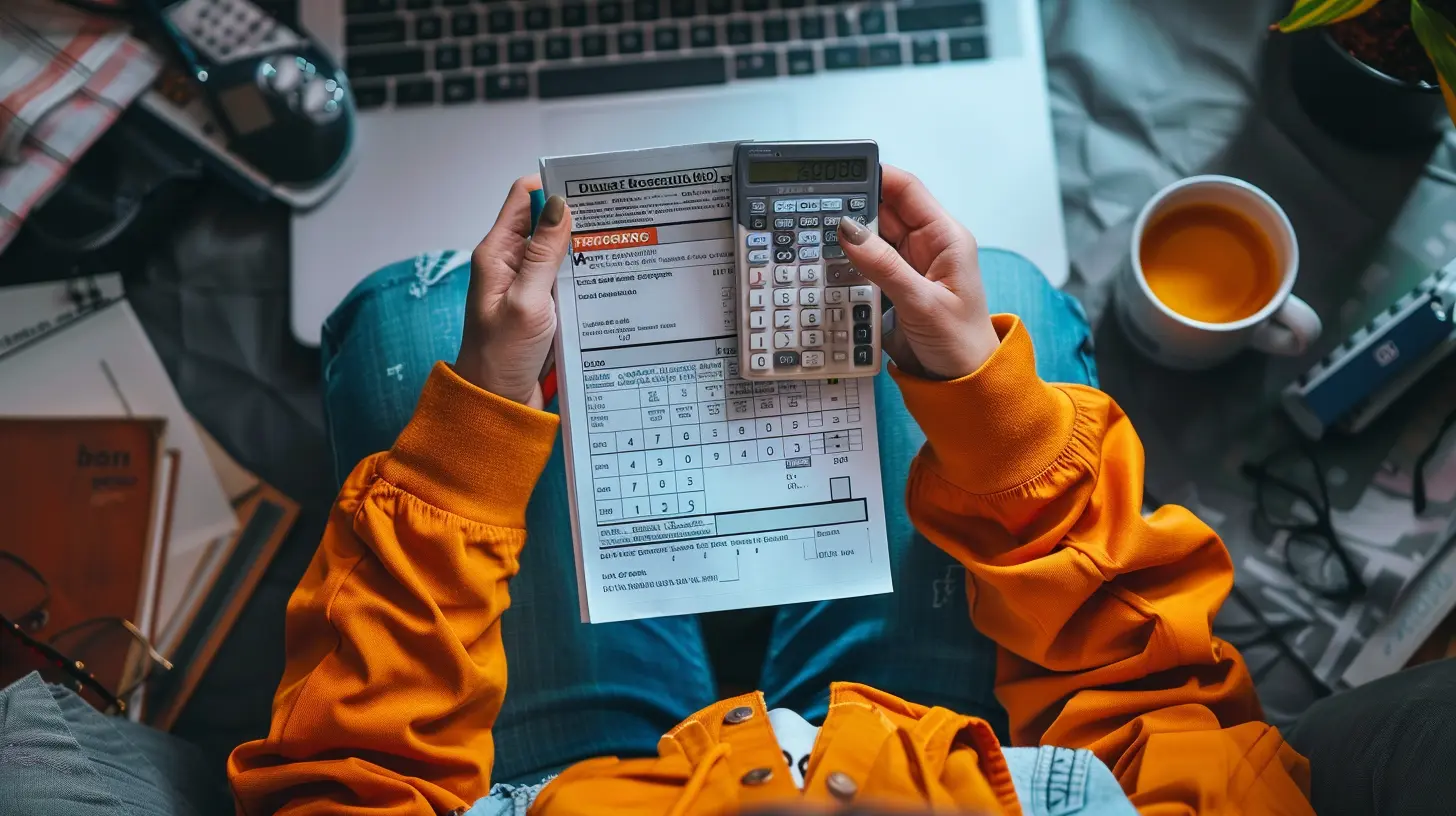Don’t Miss Out: Tax Refund Tips for Students and Recent Graduates
12 October 2025
Let’s be real for a second—tax season isn’t exactly the highlight of the year. For most people, it's a confusing mix of paperwork, numbers, and cringing at every financial decision made in the past 12 months. But hey, if you're a student or a fresh-outta-college grad, you might be leaving money on the table without even knowing it.
Yup, that’s right—you could be due for a juicy tax refund and not even know the tricks for claiming it!
In this guide, we’re going to walk through some simple-yet-powerful tax refund tips specifically for students and recent graduates. No financial jargon, no math degrees needed—we're keeping it chill and 100% helpful.

First Things First: Why Tax Refunds Even Matter
You ever wonder why you get a random check or a bank deposit in the spring that feels like a bonus? That’s your tax refund. It's basically the government saying, “Hey, we took too much of your money last year—here’s some of it back.”But it’s not automatic magic. You’ve gotta file taxes to get that refund. If you’re working part-time jobs, internships, or side gigs during school, there’s a good chance you’ve had taxes withheld from your paycheck.
And guess what? You may have paid more than you owed.

Do Students Really Need to File Taxes?
Short answer: Probably.Long answer: If you made any money—even as little as a few hundred bucks—your employers likely withheld federal income taxes. Filing a tax return lets you claim that money back if you didn’t actually owe it.
Here are a few cases where a student should definitely file:
- You made over $13,850 (2023 standard deduction for single filers) — filing is required.
- You had a part-time job and want to get back the taxes that were taken out.
- You received a 1098-T form (tuition statement) from your school. That could mean tax credits, folks.
- You received scholarships, grants, or fellowships—some of which might be taxable.
Moral of the story? File the dang taxes. Even if you don’t have to, you might benefit big-time.

The Power of the Standard Deduction
Here’s a secret that barely anyone talks about when you're new to taxes—the standard deduction is your BFF.For 2023, that amount is:
- $13,850 for single filers
- $27,700 for married couples filing jointly
If you earned less than that, guess what? You probably don’t owe any income taxes. And if you had federal taxes withheld, you’re likely due for a refund.

Tax Credits Every Student Should Know About
Okay, now let’s talk about tax credits—aka free money from the government in some cases. Yes, we’re not kidding.1. American Opportunity Tax Credit (AOTC)
This one’s a biggie. If you’re an undergrad student, the AOTC could get you up to $2,500 per year.Here’s why it rocks:
- Covers qualified education expenses like tuition, books, supplies—even computer gear.
- You can claim it for four years of post-secondary education.
- 40% is refundable, meaning you can still get up to $1,000 even if you didn’t owe any tax.
2. Lifetime Learning Credit (LLC)
Not in undergrad? Grad students, this one’s for you.- Worth up to $2,000 per tax return.
- You don’t have to be full-time—one course counts!
- Not refundable (boo), but it can lower how much you owe.
3. Student Loan Interest Deduction
Already making payments on your student loans? You can deduct up to $2,500 of interest paid throughout the year. It's an “above-the-line” deduction too, meaning you don’t need to itemize—just plug it in and lower your taxable income.Pro tip: Even if your parents are the ones who paid the interest, if the loan is in your name and you’re no longer a dependent, you can likely claim it.
Can Parents Still Claim You as a Dependent?
This matters more than you think, especially when it comes to tax credits.Generally, your parents can claim you if:
- You’re under 24 and a full-time student
- You lived with them for more than half the year
- They provided more than half your financial support
If they claim you, then you can’t claim certain credits yourself. But some credits (like the student loan interest deduction) may still be yours if you're filing solo.
It’s all about communication. Talk it out with your parents before filing, so you’re not double-claiming or missing out.
Watch for These Tax Forms
You don’t have to become a tax pro, but knowing which forms to look for helps a ton:- W-2: From employers; shows how much you earned and what was withheld.
- 1098-T: From your school; details tuition paid and scholarships received.
- 1099-INT/1099-MISC: For interest earned or freelance/contract work.
- 1098-E: For student loan interest.
Gather these up and keep them handy. They’re the golden tickets to unlocking your refund.
Don’t Forget About State Taxes
Federal refunds are great, but don’t sleep on your state tax return. Even if you moved states during college or had a part-time job that took out state tax, you're probably eligible for a refund from your local government.P.S. Some states offer their own education tax credits or deductions. Google your state’s tax department or use a tax tool to sniff those out.
How to File Your Taxes (Without Wanting to Cry)
Okay, so all this info is great, but how do you actually file?You’ve got a few no-headache options:
- IRS Free File: If you made under $73,000, you can use this. It’s no-frills but does the job.
- TurboTax, H&R Block, TaxSlayer, etc.: These tools guide you step-by-step, often free for simple student returns.
- Campus Resources: Many colleges offer free tax prep help through a VITA (Volunteer Income Tax Assistance) program.
If your situation is straightforward (part-time job + school + loan), these digital tools will walk you through it with ease.
Common Mistakes Students and Grads Make (And How to Avoid Them)
Let’s be honest—taxes can feel like walking through a room full of Legos blindfolded. Painful if you step wrong. Here’s how to sidestep the big no-no’s:Mistake #1: Not filing because “I didn’t make much”
Even if you made peanuts flipping burgers or tutoring, you likely had some taxes withheld. File and get that money back!Mistake #2: Letting parents claim you when you shouldn’t be
If you're financially independent and they claim you anyway, you could lose your refund—or worse, trigger an audit. Be real about who’s supporting who.Mistake #3: Missing deadlines
Tax Day usually falls in mid-April. Missing it means losing out on refunds and possibly racking up penalties.Mistake #4: Not checking for credits and deductions
Always check for the AOTC, LLC, and student loan deduction. These are low-hanging fruits, and skipping them is like throwing away free pizza.
What If You're Freelancing or Side-Hustling?
Ah, the gig economy—you love the freedom, but the IRS wants their cut.If you're driving for Uber, freelancing online, or selling custom socks on Etsy, you're considered an independent contractor. That means:
- No taxes are taken out of your paychecks
- You’re responsible for self-employment taxes (yes, it sucks)
- You can deduct business expenses (think: internet, laptop, mileage)
Get organized, track your income and expenses, and consider using a tax pro or premium software to help out. Uncle Sam doesn’t play when it comes to self-employed folks.
Filing for the First Time? Don’t Panic
Filing taxes for the first time can be intimidating, but like most things in adulting—it’s scary until you do it once.Here’s a quick checklist:
1. Collect your forms (W-2s, 1098-T, etc.)
2. Choose a filing method (IRS Free File, tax prep software, VITA)
3. Enter your information carefully
4. Double-check for student credits
5. Submit and track your refund
Most refunds come back in 2–3 weeks if you e-file and use direct deposit. That’s faster than your pizza delivery on a Friday night.
Refund Spent Already? Make It Count
When that sweet refund hits your bank account, it’s tempting to splurge. And hey, treat yourself a little—you earned it.But also consider:
- Building an emergency fund (3–6 months of expenses)
- Paying off high-interest debt (credit cards, anyone?)
- Putting it toward student loans
- Starting an investment fund (hello, compound interest!)
Even $100 wisely invested can grow like a tiny money tree over time.
Final Thoughts
Filing taxes might not be your idea of a fun time, but missing out on money that’s rightfully yours? That’s even worse.If you’re a student or recent graduate, you definitely don’t want to skip tax season. With the right knowledge and a little prep, you could unlock hundreds—or even thousands—of dollars in refunds and savings.
So gather those forms, hit up some tax software, and file with confidence. Your future self (and bank account) will thank you.
all images in this post were generated using AI tools
Category:
Tax RefundAuthor:

Harlan Wallace
Discussion
rate this article
1 comments
Seth Whitley
Great insights on maximizing tax refunds for students and recent grads! Utilizing credits like the American Opportunity Tax Credit and filing early can truly boost returns. Don't forget to keep track of educational expenses and consider e-filing for a faster refund process.
November 1, 2025 at 6:04 AM


